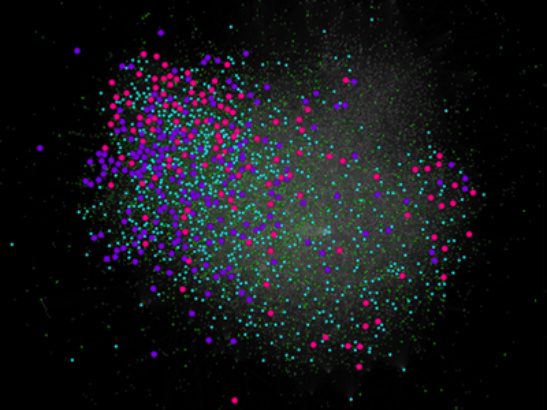Cancer Research UK-funded scientists have designed a computer model that applies techniques used to analyse social networks to identify new ways of treating cancer, according to research published in PLOS Computational Biology today.
The model analyses the unique behaviours of cancer-causing proteins – spotting what makes them different from normal proteins, and mapping out molecular targets for new potential drugs that could be developed to treat cancer.
Scientists at The Institute of Cancer Research, London, compared proteins inside cells to members of an enormous social network, mapping the ways they interact. This allowed them to predict which proteins will be most effectively targeted with drugs.
The researchers have made this map publicly available. It could provide drug discovery scientists with a short cut to finding new drugs for many different types of cancer.
The team found that there are many molecular pathways that interact to affect the development of cancer. Cancer-causing proteins that have already been successfully targeted with drugs tended to have particular ‘social’ characteristics that differ from non-cancer proteins – suggesting that previously unexplored cancer proteins with similar characteristics could also make good drug targets.
‘Hub-like’ proteins which ‘communicate’ with lots of other proteins – like a super-Facebook user with thousands of friends – were more likely to cause cancer.
This information could provide a wide range of potential targets for drug development.
Study leader Dr Bissan Al-Lazikani, Team Leader in Computational Biology and Cancer Research UK-funded scientist at The Institute of Cancer Research, London, said: “Our study is the first to identify the rules of social behaviour of cancer proteins and use it to predict new targets for potential cancer drugs. It shows that cancer drug targets behave very differently from normal proteins and often have a complex web of social interactions, like a Facebook super-user.
“Finding new targets is one of the most important steps in drug discovery. But it can be a lengthy, expensive process. The map that we’ve made will help researchers design better new drugs, more quickly, saving time and money. It also sheds light on how resistance to treatments may occur, and in just a few years could help doctors choose the best drug combinations to suit individual patients.”
Nell Barrie, Cancer Research UK’s senior science information manager said: “Thanks to research, cancer survival has doubled in the last 40 years. But we urgently need to develop better, more effective treatments so that in the future no one has to fear a cancer diagnosis. Research like this, that’s made publically available, will help speed up crucial advances in drug discovery to save more lives from cancer.”
Reference:
Bissan Al-Lazikani et al., Distinctive behaviours of druggable proteins in cellular networks, (2015) PLOS Computational Biology.
